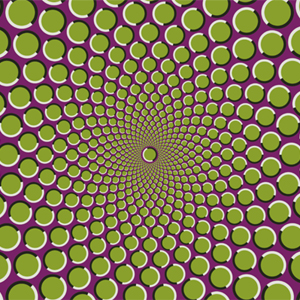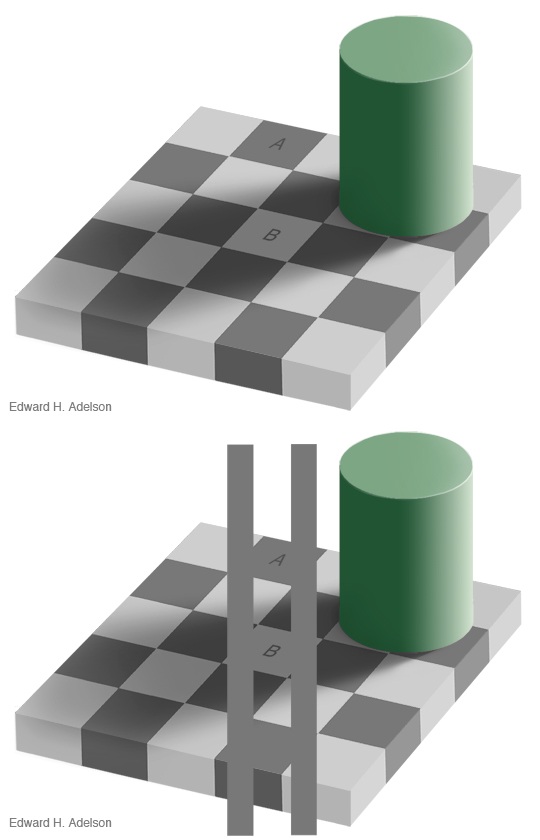The Most Amazing Optical Illusions (and How They Work)
Intro

Optical illusions harness the shift between what your eyes see and what your brain perceives. They reveal the way your visual system edits images before you're even made aware of them like a personal assistant, deciding what is and isn't worthy of your attention.
People were creating optical illusions long before we knew what made them work. Today, advances in neuroscience have pinpointed the visual processes that fool your brain into falling for many of them. Others still elude explanation.
Here, a selection of eye- and brain-boggling illusions, and explanations of how they work.
Related: What you see in this famous optical illusion could reveal how old you are
Checkered Shadow

On the checkerboard at left (click to enlarge), tile A looks much darker than tile B. Remarkably, as seen in the revised image below, A and B are actually exactly the same color. In an image editing program, they'll both register an RGB value of 120-120-120.
Edward Adelson, a professor of vision science at MIT, created this so-called "checker shadow illusion" in 1995 to demonstrate how the human visual system deals with shadows. When attempting to determine the color of a surface, our brains know that shadows are misleading that they make surfaces look darker than they normally are. We compensate by interpreting shadowy surfaces as being lighter than they technically appear to the eye. [Why Do We See In 3-D?]
Thus, we interpret square B, a light checkerboard tile that is cast in shadow, as being lighter than square A, a dark checkerboard tile. In reality, the shadow has rendered B just as dark as A.
Get the world’s most fascinating discoveries delivered straight to your inbox.
Lilac chaser

{youtube K7bgUPh4sHo}
Fixate on the crosshairs. After 20 seconds or so, the fuzzy lilac dots fade to gray. The absence of a dot, which hops around the chain, becomes a rotating dot of green.
This visual trickery is called Troxler's fading, or Troxler's effect, and was discovered by Swiss polymath Ignaz Paul Vital Troxler in 1804. The effect results from the ability of our visual neurons to switch off their awareness of things that aren't changing, and heighten their perception of things that are. In the footage, the lilac dots stay still while the absence of the dots moves. Thus, after a brief figuring-out period, the visual system transitions to focusing on only the moving blank dots which it turns green because of a second illusion at play here and lets the immobile lilac dots fade. [Why Do We See In Color?]
Other human sensory systems behave similarly. If a bug lands on your arm, for example, you can feel it at first. But if it stands still for a few seconds, you lose the physical sensation of its presence. Only when it keeps walking, giving varying stimulation to your tactile neurons, do you keep feeling it.
As for the other optical illusion, the blank dot turns minty green because your retina has been oversaturated with the lilac colored dots. When the lilac is removed from the spots, you see its complementary color (minty green) instead, which is composed of white light minus the lilac.
Disappearing Light

{youtube vw101eBziHI}
After staring at the blinking light in the center of the above video for about 10 seconds, the yellow dots spaced evenly around it start to disappear. One might vanish, then reappear only to have another go away. Two or three of the dots may fade and reemerge together. These disappearances and reappearances continue at random for as long as you stay focused on the blinking light it's downright impossible to train your brain to keep them all in the picture.
This mind trick, called motion induced blindness, has no universally accepted explanation, but reserach suggests that effect arises in the primary visual cortex, the part of the brain that processes information about static and moving objects.
Hering Illusion

In this geometrical-optical illusion, discovered by the German physiologist Ewald Hering in 1861, two straight and parallel lines look as if they bow outwards. Hering ascribed the effect to our brains overestimating the angle made at the points of intersection between the radiating lines and the red ones. But why do we miscalculate? [How Do Calculators Calculate?]
Researcher Mark Changizi of Rensselaer Polytechnic Institute in New York believes it has to do with the human tendency to visually predict the near future. Because there's a lag between the time that light hits the retina and the time when the brain perceives that light, Changizi thinks the human visual system has evolved to compensate for the neural delay by generating images of what will occur one-tenth of a second into the future. He explained the Hering illusion in a 2008 article on LiveScience, a sister site to Life's Little Mysteries:
"Evolution has seen to it that geometric drawings like this elicit in us premonitions of the near future. The converging lines toward a vanishing point (the spokes) are cues that trick our brains into thinking we are moving forward as we would in the real world, where the door frame (a pair of vertical lines) seems to bow out as we move through it and we try to perceive what that world will look like in the next instant."
Gradient Illusion

The horizontal bar in the above image looks gradated, moving from light to dark gray in the opposite direction as the background. You may have already guessed it: This is just a trick of the mind. If you cover everything but the bar itself, you'll see that it's actually monochrome.
The so-called "simultaneous contrast illusion" is similar to the checker shadow illusion shown in the first slide. The brain interprets the two ends of the bar as being under different illuminations, and deduces what it thinks the bar's true shading would be (if it were lit evenly along its length). It deduces that the left end of the bar is a light gray object in dim lighting. The right end looks like a darker object that is well-lit.
Illusory motion

Nothing is moving here. Promise.
There's no solid explanation for illusory motion. Some visual scientists think it has to do with fixation jitter: involuntary eye movements that give the illusion that objects near what you're fixated on are moving. Others think that when you glance around the image, motion detectors in your visual cortex get "confused" by dynamical changes in neurons, and think you're seeing movements. Whatever the explanation, it accounts for the illusory motion in the intro slide, too.
Natalie Wolchover was a staff writer for Live Science from 2010 to 2012 and is currently a senior physics writer and editor for Quanta Magazine. She holds a bachelor's degree in physics from Tufts University and has studied physics at the University of California, Berkeley. Along with the staff of Quanta, Wolchover won the 2022 Pulitzer Prize for explanatory writing for her work on the building of the James Webb Space Telescope. Her work has also appeared in the The Best American Science and Nature Writing and The Best Writing on Mathematics, Nature, The New Yorker and Popular Science. She was the 2016 winner of the Evert Clark/Seth Payne Award, an annual prize for young science journalists, as well as the winner of the 2017 Science Communication Award for the American Institute of Physics.

